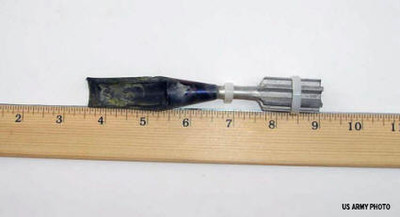US Army’s Depleted Uranium Licencing Saga Highlights Post-Conflict Contradictions
MILITARISM, 2 May 2016
International Coalition to Ban Uranium Weapons – TRANSCEND Media Service
23 Mar 2016 – It has taken a decade but the US Nuclear Regulatory Commission (NRC) has finally granted the US Army a licence to possess and manage DU weapon residues at 15 US installations. However the domestic regulatory framework imposed by the NRC stands in stark contrast to the absence of obligations governing the management of contamination caused by US military actions in Iraq and elsewhere.
This week’s decision by the NRC to grant the US Army a possession and management licence for 15 of its installations known to be contaminated by DU brings to an end a long-running saga that began in 2006 with the discovery of DU on two ranges on Hawaii – Schofield Barracks, Oahu and the Pohakuloa Training Area on the island of Hawaii.
The DU discovered in 2006 was from M101 spotting rounds – these were used in training for the 1960s Davey Crockett tactical nuclear weapon system. As the system was classified, few records were kept of which installations received the rounds and where they were fired. Each M101 round was 92% DU and 8% molybdenum, which equated to 190g of DU per round; the rounds were fused and also contained white phosphorous. In all, 75,318 rounds were originally produced. Of these, 44,000 were eventually demilitarised by firing them into a sand box where they were produced at the Lake City Ammunition Factory Missouri, a further 2,000 were used for quality testing. The whereabouts of the remaining 29,300 rounds was something of a mystery to the US Army – but equated to around 5,560kg of DU.
The Army clashes with the NRC and campaigners
The US Army initially denied that DU was present on Hawaii but eventually admitted its presence after concerned local activists undertook their own radiation monitoring campaign in 2007. In 2008, Hawaii County Council passed a resolution requiring that the Army cease all live firing at the range due to concerns that the explosions would mobilise contaminated soil and allow it to be blown off site. The resolution also called for the clean-up of the ranges.
The Army grudgingly submitted an application to the NRC in 2008, all the while maintaining that: “While the U.S. Army has not determined that the Atomic Energy Act (Act) requires a license in this situation, we are providing this application to promote cooperation between our agencies and to the extent required by the Act.” The NRC took a different view, and would later find that: “The Army has enough DU at these sites that, under the Atomic Energy Act and NRC regulations, it is required to have a possession license.”
The licence for the two Hawaiian ranges was eventually granted in 2013, but not before years of wrangling between the Army and the NRC. Throughout the period, the Army dissembled, bluffed and frequently found itself facing the ire of the NRC, as well as sustained pressure from Hawaiian politicians and environmental and community activists. Even when the licence was granted, it did not give the Army carte blanche, instead the licence provides for “…NRC inspections and requires the Army to implement a radiation safety plan and a physical security plan. The Army must also provide an air and plant sampling plan for NRC review within 90 days. The NRC must review sampling results before deciding whether to lift existing restrictions on activities that would disturb the DU. The license does not authorize the Army to use the DU or decommission the sites without additional review and approval by the NRC.”
By this time, the question of the whereabouts of the remaining M101 rounds had resulted in the Army having to seek to expand the licence to cover a further 13 installations following an internal review: Forts Benning and Gordon (Georgia); Forts Campbell and Knox (Kentucky); Fort Carson (Colorado); Fort Hood (Texas); Joint Base Lewis-McChord/Yakima Training Center (Washington); Fort Bragg (North Carolina); Fort Polk (Louisiana); Fort Sill (Oklahoma); Fort Jackson (South Carolina); Fort Hunter Liggett (California); Fort Wainwright (Alaska); Joint Base McGuire-Dix-Lakehurst (New Jersey); and Fort Riley (Kansas).
Contrasting regulations
As with the initial agreement on the Hawaiian installations, the licence agreed by the NRC this week requires the Army to submit to inspections and periodic reviews. The licence also requires the Army to meet NRC health and environmental standards and it limits the amount of DU that can be held at each site. Any work to decommission or clean-up sites would require further approval from the NRC.
The contrast with the strict US domestic regulatory framework for DU contaminated sites and the US military’s response to DU following its use in conflict could not be starker. The US has consistently opposed measures to increase transparency over DU use at the UN. It has objected to any suggestion that there might be health or environmental risks associated with its use in conflict. The US and others are also of the view that they are under no obligation to deal with contamination and that it remains the sole responsibility of the country affected. Following the 2003 Iraq War, the US authorities were reluctant to extend any decontamination work to beyond their own bases, or share information on target locations with the Iraqi government. This Janus-like view extends to risk awareness, where the measures now adopted by many militaries to protect their own troops are rarely extended to the civilian population.
These views and practices, which utterly reject the radiation protection and management frameworks that exist for domestic DU use, continue to exist because of the lack of formal obligations for the post-conflict management of DU contamination. Time and again, DU-affected countries lack the financial and technical capacity to manage DU effectively – even to their own national standards, let alone those applicable domestically for the countries responsible for using the weapons. This glaring disparity leaves communities at risk of exposure and places an unwelcome burden on states recovering from conflict.
The saga of the M101 contamination should serve as a reminder of the contradictory and often hypocritical approach taken by the states that employ DU weapons – and of the challenge that the use of DU weapons poses to fundamental international radiation protection norms.
NOTE:
The formal record of the NRC licence decision is available here: https://www.gpo.gov/fdsys/pkg/FR-2016-03-28/pdf/2016-06947.pdf
Go to Original – bandepleteduranium.org
DISCLAIMER: The statements, views and opinions expressed in pieces republished here are solely those of the authors and do not necessarily represent those of TMS. In accordance with title 17 U.S.C. section 107, this material is distributed without profit to those who have expressed a prior interest in receiving the included information for research and educational purposes. TMS has no affiliation whatsoever with the originator of this article nor is TMS endorsed or sponsored by the originator. “GO TO ORIGINAL” links are provided as a convenience to our readers and allow for verification of authenticity. However, as originating pages are often updated by their originating host sites, the versions posted may not match the versions our readers view when clicking the “GO TO ORIGINAL” links. This site contains copyrighted material the use of which has not always been specifically authorized by the copyright owner. We are making such material available in our efforts to advance understanding of environmental, political, human rights, economic, democracy, scientific, and social justice issues, etc. We believe this constitutes a ‘fair use’ of any such copyrighted material as provided for in section 107 of the US Copyright Law. In accordance with Title 17 U.S.C. Section 107, the material on this site is distributed without profit to those who have expressed a prior interest in receiving the included information for research and educational purposes. For more information go to: http://www.law.cornell.edu/uscode/17/107.shtml. If you wish to use copyrighted material from this site for purposes of your own that go beyond ‘fair use’, you must obtain permission from the copyright owner.

